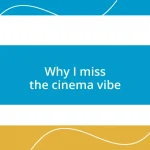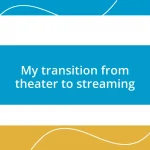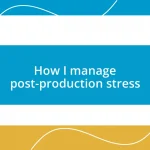Key takeaways:
- The collaboration between directors and cinematographers requires trust, open communication, and appreciation to foster a cohesive creative team.
- Effective pre-production planning and clear visual communication, through mood boards and emotional discussions, enhance alignment on artistic vision.
- Utilizing feedback through reflection and constructive criticism can lead to unexpected breakthroughs and growth in the creative process.

Understanding the role of cinematographers
Cinematographers, or Directors of Photography (DoPs), are the visual storytellers behind the lens. They translate a script’s emotional tone into stunning imagery, ensuring each shot contributes to the overall narrative. Have you ever watched a scene and felt it resonate on a deeper level? That’s the magic of a cinematographer’s work—it evokes emotions through composition, lighting, and movement.
I remember working on a short film where the cinematographer painstakingly adjusted every light, creating a warm glow that perfectly captured the protagonist’s longing. It was a dance of shadows and highlights that made me realize just how crucial their role is in shaping the viewer’s interpretation of a story. Their artistic choices can turn a simple location into a character of its own, influencing how audiences perceive the story at its core.
The collaboration between a director and a cinematographer is a unique bond, driven by shared vision and trust. Questions fly around during production: “How do we want the audience to feel in this moment?” Each decision impacts the film’s heart, and watching how a cinematographer approaches these challenges enriches my understanding of the craft. In essence, they are not just technical experts but passionate artists who breathe life into the script through their lens.

Building relationships with cinematographers
Building relationships with cinematographers is essential for creating a harmonious working environment. Trust is a cornerstone of this collaboration. During my time on a feature film, I made it a point to spend time with the cinematographer outside of our scheduled meetings. We shared coffee and talked about our influences—this not only broke the ice but also helped us align our artistic visions, making communication smoother on set.
In my experience, clear and open communication establishes a solid foundation for any professional relationship. I vividly recall a moment when a cinematographer and I were brainstorming the look of a critical scene. We explored various ideas, and with each exchange, our concepts evolved collaboratively. This back-and-forth fostered a sense of ownership for both of us over the final product. The joy in discovering new angles together was not just fulfilling—it deepened our connection as artists.
Finally, I believe recognizing a cinematographer’s contributions boosts morale and reinforces partnerships. I always express appreciation for their creativity and hard work. When a cinematographer suggested an unorthodox shot that ultimately elevated a scene, acknowledging their brilliance made them feel valued. It’s these little gestures of gratitude that solidify relationships, transforming colleagues into a cohesive creative team.
| Key Aspect | Importance |
|---|---|
| Trust | Enables open communication and artistic freedom. |
| Collaboration | Invites diverse ideas, leading to innovative solutions. |
| Appreciation | Enhances team morale and fosters long-term relationships. |

Communicating creative visions clearly
When it comes to communicating creative visions clearly, I find it essential to share a specific visual language that resonates with both the cinematographer and myself. I’ve made it a practice to create mood boards filled with images that capture the essence of what I envision for a project. It’s fascinating to witness how just a few visual stimuli can spark a profound conversation. For instance, during one of my projects, I brought in a collection of photographs depicting color palettes that reflected the film’s emotional tone. The exchange of ideas that followed was electric; we bounced thoughts and interpretations off each other, and suddenly the vision felt more tangible.
- Visual References: Use mood boards or reference images to align your creative concepts.
- Frequent Check-Ins: Schedule casual discussions during production to keep the creative dialogue open.
- Collaborative Scene Breakdowns: Break down each scene together, fostering a shared understanding of its visual dynamics.
Another approach I take is to embrace storytelling discussions. Beyond technical jargon, I share the emotional weight of each scene and how I hope it resonates with the audience. This deeper dive into the “why” behind our choices can ignite passion in a cinematographer. I recall a conversation where I expressed that the darkness in a scene could represent the protagonist’s internal struggle. The cinematographer responded with ideas about lighting that literally illuminated the character’s journey, turning my abstract thoughts into a visual metaphor. This synergy reminded me that articulating emotions genuinely leads to profound artistic collaboration.
- Discuss Emotional Goals: Focus on the feelings you wish to evoke in the audience for deeper connection.
- Encourage Exploration: Invite the cinematographer to share their interpretations and ideas.
- Celebrate A-Ha Moments: Recognize when an idea clicks; these moments fuel creative chemistry.

Collaborating during pre-production planning
When diving into pre-production planning, I like to invite my cinematographer into my creative process from the get-go. I remember one project where, during our initial discussions, we sketched out a scene together on a whiteboard. As I scribbled down thoughts, I could see the excitement in their eyes, and it became clear that collaborating on this level would lead us to an innovative setup neither of us had envisioned separately.
As we outlined the shooting schedule, I found it crucial to synchronize our timelines. In one memorable instance, we planned a day that involved tight scenes with dynamic lighting. By coordinating our needs early on, we ensured that each element was well-prepared—this clarity not only minimized stress, but also allowed us to focus on creativity. Isn’t it satisfying to see how well-laid plans can foster extraordinary results?
Moreover, I always encourage my cinematographer to voice any concerns early in the process. During another project, they raised an issue about a particular location’s lighting conditions that I hadn’t considered. Addressing this in our pre-production meetings not only resolved potential headaches on the shooting day but also strengthened our trust. After all, when both of us feel heard, the overall result naturally elevates.

Working together on set
There’s something really magical about the teamwork that happens on set. During one shoot, I vividly remember a moment when the cinematographer and I were adjusting the framing for a crucial scene. As we played with different angles, I felt a jolt of excitement; it was like we were dancing, each adjustment feeding into the other’s creativity. That instinctive back-and-forth is invaluable; it makes everything feel fluid and alive. I often wonder, isn’t that what great filmmaking is all about—finding harmony in collaboration?
Frequent check-ins during the shoot can significantly enhance our synergy. I make it a point to pause at specific moments, asking for input or sharing observations about the shot. Recently, while filming a tense, emotional confrontation, my cinematographer suggested a tighter close-up that brought forth the raw intensity of the actors’ performances. That kind of fluid dialogue not only improves our shots but also fosters an atmosphere of trust and openness. How fulfilling it is to know that our ideas can evolve right before our eyes!
After a long day of shooting, I always value the debriefing sessions we have. I recall an instance when we sat down to watch the day’s footage together, sharing laughter and excitement over what worked beautifully and discussing ways to enhance the next day’s scenes. Those moments remind me of the joy in celebrating our collective successes and learning from our stumbles. It’s all about nurturing that ongoing conversation, even when the cameras stop rolling. Don’t you think that’s when the true magic of collaboration takes place?

Utilizing feedback for improvement
Utilizing feedback is integral to refining our work, especially in a dynamic setting like film production. During a recent project, I found myself overwhelmed by the sheer volume of footage captured. I invited my cinematographer to provide feedback on the initial cuts. Their fresh perspective highlighted elements I missed, ultimately steering the narrative towards a more compelling direction. How often do we overlook vital details that someone else might see clearly?
It’s fascinating how discussions evolve when we actively seek constructive criticism. One day, after reviewing some scenes, my cinematographer pointed out that certain lighting choices didn’t evoke the intended mood. Initially, I felt defensive, but I took a step back and asked more questions. This openness enabled us to collaborate on new lighting techniques that transformed the visuals significantly. Isn’t it amazing how embracing feedback can lead us to unexpected breakthroughs?
My favorite part of this process is the after-action review. I recall a shoot wrapped up in a blur of excitement, but once the adrenaline settled, we gathered to reflect on what worked and what didn’t. This ritual not only cements our bond but helps us grow as artists, ensuring that our next endeavor benefits from our collective insights. How refreshing it is to know that every conversation—whether critical or celebratory—fuels our passion for storytelling!

Reflecting on collaboration experiences
Reflecting on past collaborations brings a mix of nostalgia and growth. I remember working with a particularly skilled cinematographer who had a strategic way of framing shots. During a night shoot, our discussions led to an impromptu choice of lighting that turned an ordinary scene into something ethereal. It struck me then how such discussions, even late into the night, illuminated our creative paths. How can one moment of shared imagination reshape the entire outcome of a project?
There was a project where our differing visions initially created tension. I was adamant about a certain style, while my cinematographer envisioned something more avant-garde. Through candid conversations, we explored each other’s ideas—not just why we liked them, but how they could complement one another. That process challenged my perspective significantly, and I learned that embracing contrasting views can lead to beautiful cinematic surprises. Isn’t it intriguing how friction can spark the most brilliant ideas?
Looking back, I cherish those moments of doubt and triumph alike. A particular challenge stands out when we struggled to convey a character’s internal conflict. After some trial and error, we captured a shot that depicted both vulnerability and strength. It left me in awe of our collective growth. These experiences reaffirm that collaboration isn’t just about creative output; it’s about shared journeys. What better way to grow as storytellers than to walk this path together?














